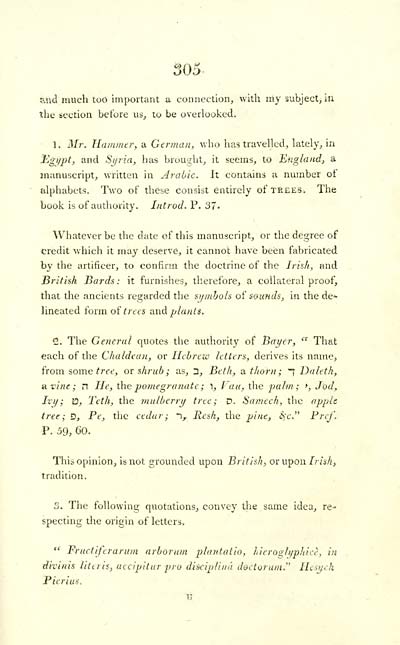Blair Collection > Celtic researches, on the origin, traditions & language, of the ancient Britons
(397)
Download files
Complete book:
Individual page:
Thumbnail gallery: Grid view | List view

305
ν•Λίά much too important a connection, with my subject, in
tliu section before us, to be overlooked.
1. Mr. Hammtr, a German, who has travelled, lately, in
3^gi/pt, and Sjjria, has brought, it seems, to England, ä
manuscript, written in Arabic. It contains a number of
alphabets. Two of these consist entirely of trees. The
book is of authority. Introd. P. 37.
Whatever be the date of this manuscript, or the degree of
credit which it may deserve, it cannot have been fabricated
by the artificer, to confirm the doctrine of the Irish, and
British Bards : it furnishes, therefore, a collateral proof,
that the ancients regarded the symbols of sounds, in the de*
lineated form of in es ana plants.
2. The General quotes the authority of Bayer, " That
each of the Chaldean, or licbrezo letters, derives its name>
from some tree, or shrub; as, D, Beth, a thorn; 7 Daleth,
■A vine; π He, the pomegranate ; 1, Van, the palm; ', Jod,
Ivy; ÌD, Teth, the mulberry tree; D. Samech, the apple
tree; D, Pe, the cedar; 1^ Resh, the pine, ijc." Frcf,
P. 59, 60.
This opinion, is not grounded upon British, or upon Irishy
tradition.
S. The following quotations^ convey the same idea, re-
specting the origin of letters.
'' Fructiferaru/n arborum jjlantatio, Lierogli/phicè, in
divinis Uteris, acc/pitur pro di^^ipiinn doctoruni.'" Ilcsycli
Pierius.
ν•Λίά much too important a connection, with my subject, in
tliu section before us, to be overlooked.
1. Mr. Hammtr, a German, who has travelled, lately, in
3^gi/pt, and Sjjria, has brought, it seems, to England, ä
manuscript, written in Arabic. It contains a number of
alphabets. Two of these consist entirely of trees. The
book is of authority. Introd. P. 37.
Whatever be the date of this manuscript, or the degree of
credit which it may deserve, it cannot have been fabricated
by the artificer, to confirm the doctrine of the Irish, and
British Bards : it furnishes, therefore, a collateral proof,
that the ancients regarded the symbols of sounds, in the de*
lineated form of in es ana plants.
2. The General quotes the authority of Bayer, " That
each of the Chaldean, or licbrezo letters, derives its name>
from some tree, or shrub; as, D, Beth, a thorn; 7 Daleth,
■A vine; π He, the pomegranate ; 1, Van, the palm; ', Jod,
Ivy; ÌD, Teth, the mulberry tree; D. Samech, the apple
tree; D, Pe, the cedar; 1^ Resh, the pine, ijc." Frcf,
P. 59, 60.
This opinion, is not grounded upon British, or upon Irishy
tradition.
S. The following quotations^ convey the same idea, re-
specting the origin of letters.
'' Fructiferaru/n arborum jjlantatio, Lierogli/phicè, in
divinis Uteris, acc/pitur pro di^^ipiinn doctoruni.'" Ilcsycli
Pierius.
Set display mode to: Large image | Transcription
Images and transcriptions on this page, including medium image downloads, may be used under the Creative Commons Attribution 4.0 International Licence unless otherwise stated. ![]()
| Early Gaelic Book Collections > Blair Collection > Celtic researches, on the origin, traditions & language, of the ancient Britons > (397) |
|---|
| Permanent URL | https://digital.nls.uk/75768262 |
|---|
| Description | A selection of books from a collection of more than 500 titles, mostly on religious and literary topics. Also includes some material dealing with other Celtic languages and societies. Collection created towards the end of the 19th century by Lady Evelyn Stewart Murray. |
|---|
| Description | Selected items from five 'Special and Named Printed Collections'. Includes books in Gaelic and other Celtic languages, works about the Gaels, their languages, literature, culture and history. |
|---|

